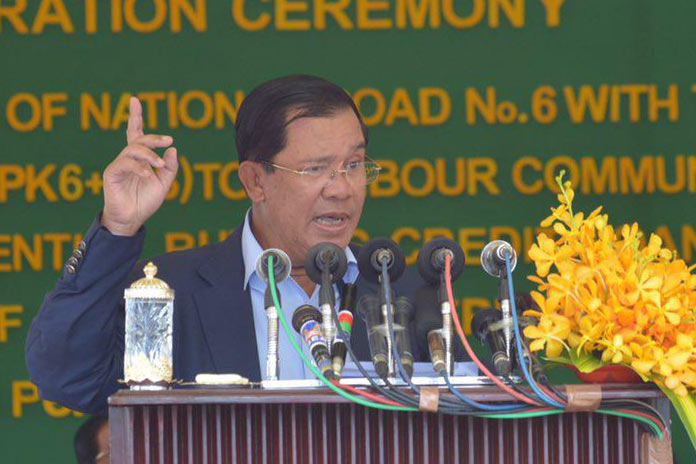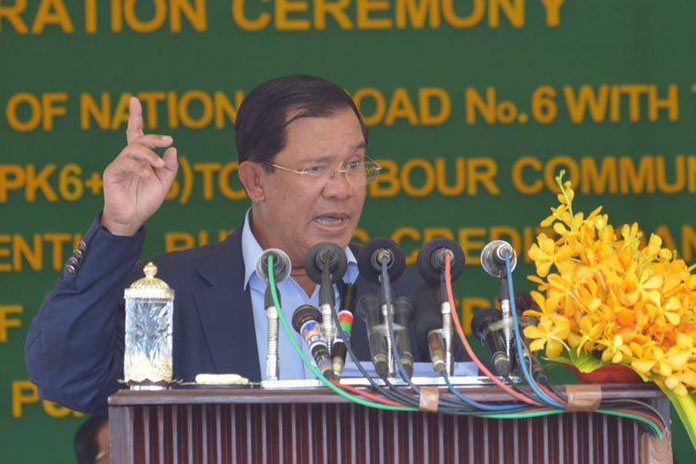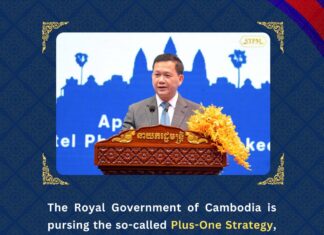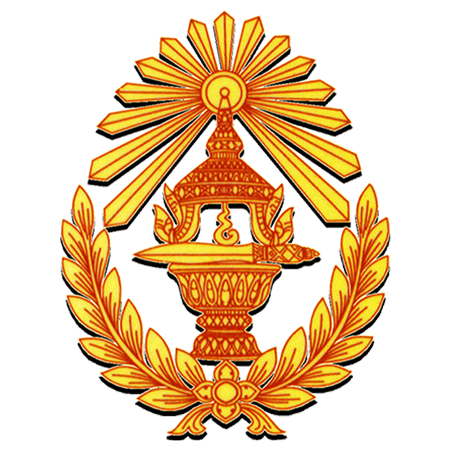[Unofficial Translation]

… The wind and rain last night blew down tents erected to give shade to our people. People have had to sit or stand without roof today to put into operation officially the some Forty-Kilometre former national road 6A, running from Phnom Penh through Kandal to Kompong Cham provinces, financed by the People’s Republic of China. I am so happy that we are here together with the Chinese Ambassador for the inauguration of this great achievement before the Khmer New Year, after we threw similar ceremony for the Morodok Techo Sports Complex the day before yesterday. These are achievements born from fruitful comprehensive cooperation, friendship and partnership between Cambodia and China.
Please allow me to give some background about how do we go about building this road. While visiting Cambodia in his capacity then as Vice President of the People’s Republic of China, HE Xi Jinping approved my request. We had a signing ceremony to mark the agreement to use an amount of some 400 million USD on eight infrastructural projects on 21 December 2009. Among them, we had approved the funding to expand the National Road 6 from a width of 7 meters to 20 metres, two lanes on each side. Some economists in those days did not believe the National Road 6 play such important role in the Cambodian economic development.
In the 1990s, because of limited understanding of such role, road construction in Cambodia was only seven meters in width. In reality, the national road 6 has played a critical role in national economic growth. Minister of Transports and Public Works HE Sun Chanthol and HE Ambassador of China already shared with us on the road’s importance. The national road 6 is in fact one of the busiest roads in Cambodia and this section of the road connects Phnom Penh to various provinces through Kandal to the border with Thailand […] I am sure that now economists understand how farsighted we are on construction of this road and the various roads connecting to it […]
Looking for Chinese Help in Building a Road from Samlot to Koh Kong
… (the Chinese assistance) also built us the Cambodian-Chinese Friendship bridge at Prek Tamak and the national road 8. In the time to come, thanks to the visit of President Xi Jinping in Cambodia, we will rebuild the national road 11 that links the national road 1, crossing national road 8, through to national road 7. On the other side of the Tonle Sap River, the Chinese assistance helps us build the national road 5 with the Prek Kadam bridge […]. Aside from ring road around Phnom Penh, we inaugurated recently, and I have a road construction map here with me, we are looking for assistance in building a ring road along the Cambodian border with neighbouring countries. We are considering asking our Chinese friend for a road that runs from Samlot of Battambang, through Thmoda of Pursat to Koh Kong/Kompong Som.
Thank China and Will Join the One Belt One Road Conference
I am taking this opportune moment to express to HE Ambassador and our Chinese friends and through them to the government and people of China, for always supporting the Cambodian infrastructural project. Whatever the Cambodian side decides is a priority, our Chinese friends always respect our decision, for instance to enlarge this road into a four lanes one. Now, in the comprehensive strategic partnership framework and this initiative of One Belt One Road, put out by President Xi Jinping, Cambodia and some other countries will benefit from it. China already earmarked 40 billion USD in 2015 for the Silk Road initiative and added up more of their assistance to the China-ASEAN framework. I thank China very much. I will take my time to participate in the conference on One Belt One Road in China in May, and conduct my official visit to China too.
Infrastructural Development Policy Distributes Economic Growth Equitably
… Our main objective is to focus on infrastructural development. It continues to be the prioritized policy of the Cambodian People’s Party in the course of its leadership. There is no better and more equitable choice than using economic growth and receiving support from friends in developing infrastructures such as roads, water canals, electricity, and those relating to education and health. For example, to build a road. People – rich or poor – are traveling on it. It also narrows the gaps between those in urban and rural areas. While people in the city have access to asphalted roads, people in rural also do. The same is true with regard to electricity. It is in this regard that we have the need to seek more funding from development partners, and our friend, the People’s Republic of China, has become the biggest financier […]
Cost of Road Construction Adds Up Impact Costs
… To build or expand a road is always bearing impacts. We have provided counterpart funding of about 6 million USD to resolve issues relating to impacts, and mines and/or UXOs. As for this road, along with loan of 68 million USD from China, we also spent, with tax included, this much of money making its total coast 88 million USD. However, the cost of building this road in cash total 70 million USD […]
We have decided to build up this road to help with settlement of our people in this part of the city. People could have understood why the Royal Government of Cambodia decided to build a sports complex Morodok Techo in the area of Prek Tasek. Well, in any case, Prek Tasek in 2023 will not be far (because of infrastructural development) […]
This is what we have achieved in infrastructural development and it gives us the opportune moment to realize high economic growth within 7.7% over the past 20 years, and later after the world and regional financial crisis and economic downturn, we have maintained a growth within 7%. It is because of such sustained growth thanks to the leadership of the Cambodian People’s Party and the Royal Government that Cambodia has liberated itself from low-income country status to lower-middle income country. We will keep the momentum […]
There Will Be Development As Long As There Is Peace
I think I should not continue because I have spoken too much. Tomorrow I will hurry to participate in the National Assembly session and listen to the message of HM the King. After that, I will leave for another meeting with some four thousand civil servants […] I thank the company Shanghai and its technical consultant for their very good jobs. I thank Samdech, Excellency, Ladies and Gentlemen, especially people from Kandal province and from Phnom Penh, for their presences in this auspicious ceremony.
Originally, this section here was formerly parts of Kandal province. They have just become parts of Phnom Penh lately. In 1988, I made a decision to cut out some parts of Kandal province (to make them parts of Phnom Penh), while its border was before up to the bridge of Jroy Jangva. In those days when HE Thong Khon was mayor of Phnom Penh. We sent youth and officials from various institutions in Phnom Penh to clear the forest in this area. The idea was to take away former Khmer Rouge forces to mount H12 rockets threatening Phnom Penh […]
… (For this Khmer New Year) we are going to dance with many new songs and rhythms. We may notice that some people already started their Khmer New Year welcoming games already. People may continue to enjoy this event under the roof of peace and new achievements in the Kingdom of Cambodia. As long as we are keeping peace, there will be development. Should there be no peace, there would not be development. Destruction would occur not only on infrastructure but also on human life.
Look, in 1970s, the war exploded and people suffered. They had to go through bombardments and deaths every day. The genocide also took people’s life and property. We have made great efforts with involved parties for the achievement of national reconciliation and peace. Finally, after spending some two billion USD, UNTAC (United Nations Transitional Authority in Cambodia) withdrew and left Cambodia under two controls – one under the Phnom Penh government and another under the Khmer Rouge along the Thai-Cambodian border.
Once again, I had to risk my life again to enter the former foe’s areas for the sake of ending protracted war created by the former generations. With rebellions led by Ee Chhien and Sok Pheap in Pailin and Malai, I took the opportune moment to work for integration of Oral area under Keo Pung’s leadership through win-win policy. We all are sitting together now. We all are Cambodians. This has been the core essence of national reconciliation […]./.





![Selected Comments Samdech Moha Bovor Thipadei Hun Manet, at the ritual ceremony to inaugurate Lotus-like Stupa in Wat Mony Ratanaream, Pursat Province [Unofficial and translation]](https://pressocm.gov.kh/wp-content/uploads/2024/04/240331-PM-POSAT-100x70.jpg)

